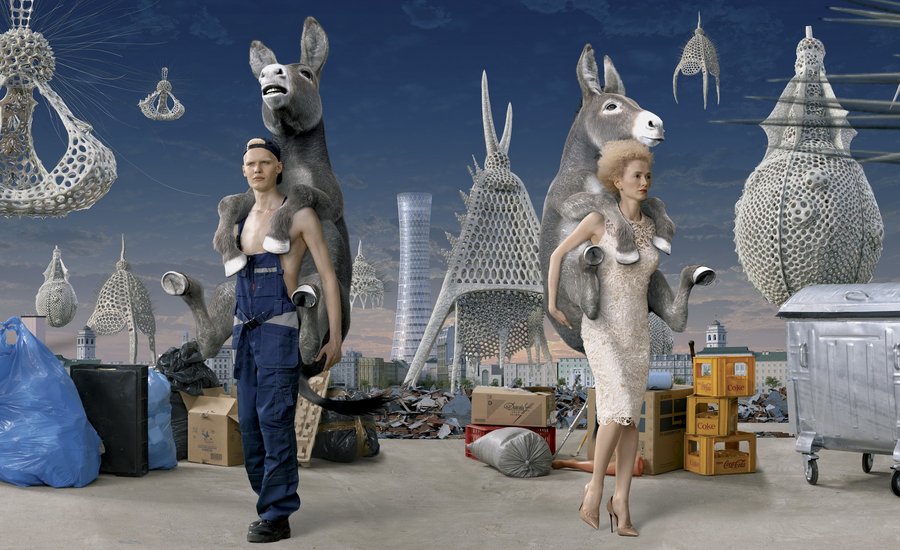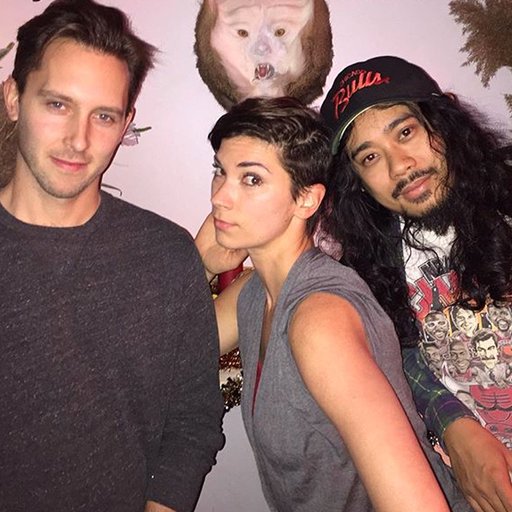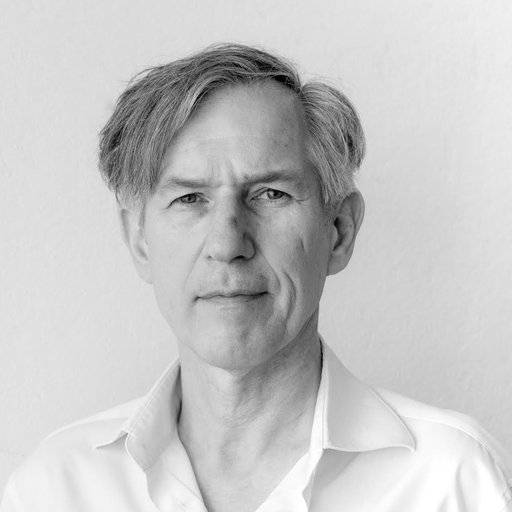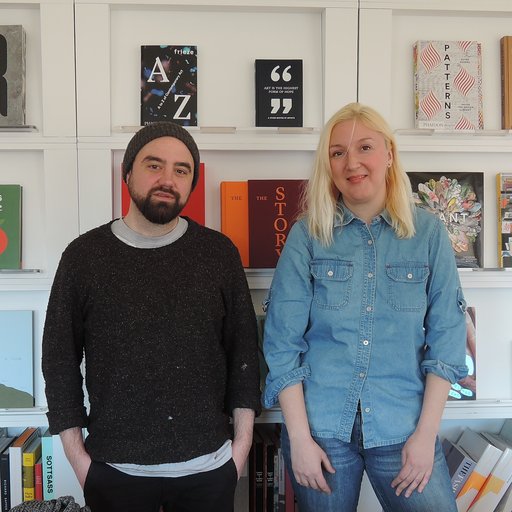The video work of AES+F is almost certainly unlike anything else. Typically shown on very large screens, the videos aren't filmed with video cameras, but instead are made by stitching together thousands of photographs to produce an ultra high-definition moving image. Rendering surrealist, dystopic futures, AES+F builds dramatic narratives that recall both the simulated violence of video games and the glamour of high fashion photography, while their subjects pierce one another with arrows, beat each other up with golf clubs, or become gutted by the members of the animal kingdom of an alternate universe.
The Moscow-based collective is comprised of four Russian artists born in the mid- to late-1950s: Tatiana Arzamasova, Lev Evzovich, Evgeny Svyatsky, and Vladimir Fridkes. (The first letters of their last names make up their group title.) Here, Artspace’s editor-in-chief Loney Abrams speaks with the collective over Skype about their mind-melding high-definition animation process, the renewed resonance of their 1990s “Islamic Project,” and what it means to make art about politics without being political.
I just saw your newest video, Inverso Mundus, at NADA New York—it was amazing. I know that it’s your first video since you completed the “Liminal Space Trilogy.” Before we get into this new work, can you tell me a bit about the trilogy that preceded it?
The trilogy consists of three projects. The first project, Last Riot , is about virtual violence in video games and entertainment. This is a film, or so-called “film.” The second project is called The Feast of Trimalchio , and it’s a piece about a luxury hotel, and the leisure and pleasure of contemporary consumer culture. It represents the “contemporary paradise.” The third project, Allegoria Sacra , is devoted to contemporary globalism, and has the same name as the painting by Giovanni Bellini, which depicted purgatory. But our version of purgatory is a contemporary airport. All the cultures meet and the passengers are very different, from refugees to Chinese businessmen. It’s like a metaphor for a contemporary global system. All together, the "Liminal Space Trilogy" is about these liminal spaces. These works that formed the trilogy drew off previous works that were released between 2007 and 2011. They are not a part of the trilogy though.
Is your newest work the first of a new trilogy? Or is it a stand-alone artwork?
I think that Inverso Mundus will just be the last one.
Inverso Mundus is based on a series of 16th-century engravings that depict the world upside down. So, there’s the man carrying the donkey, the pig cutting the butcher, rich people begging for money fom the poor, etc. Why are these 16th century images relevant in the 21st century? What do they say about the world today?
The world upside down is very similar to our own sense of the contemporary world. Maybe we’re already living in this world upside down, where somehow the building are changing very fast, or have already changed, and everything is in some process. For us, these images served as a metaphor for how we understand the contemporary world now.
I would also add, that the Inverso Mundus engravings were created in the 16th century but continued to circulate in the 17 th , 18 th , and 19 th centuries in Europe. For example, Goya also used cartoon-esque subjects for his etchings and paintings. Also, we took inspiration from the Book of Miracles . It’s a 16th-century handmade book from Germany that shows illustrations of the apocalypse. We used this as information for our backgrounds.
To me, it seems like the film illustrates inequalities that may be hard to see. For example, we may take for granted the inequalities between rich and poor, gender inequality, or the fact that we eat animals and animals don’t eat us. These things are so engrained in our culture that they’ve become invisible, in a sense. But once you invert those relationships, they become clearer. Your upside down world doesn't seem speculative or futuristic, at least not in some utopian or idealistic way, because it doesn’t express equality, or equilibrium, or balance; people are still exploited. Is that an accurate reading?
We did try to exemplify the grotesque. For example, our idea was to create a society radically dominated by women rather than men—a radical feminism that we don’t see really in our reality. This is an image of the world upside down. The episode in
Inverso Mundus
called
Inquisition,
or
Women’s Labor
depicts special a torture device. Traditionally, in the Inquisition it was men who punished female witches for their extreme sexuality. But in our project, the women punish the men for their beauty and sexuality. It’s not obvious if the device is being used for punishment or as part of some kind of sexual act. Also the torture device is unique because on one hand, it was traditional to medieval construction methods. But on the other hand, we made it from IKEA furniture materials to suggest that the violence can happen in your home.
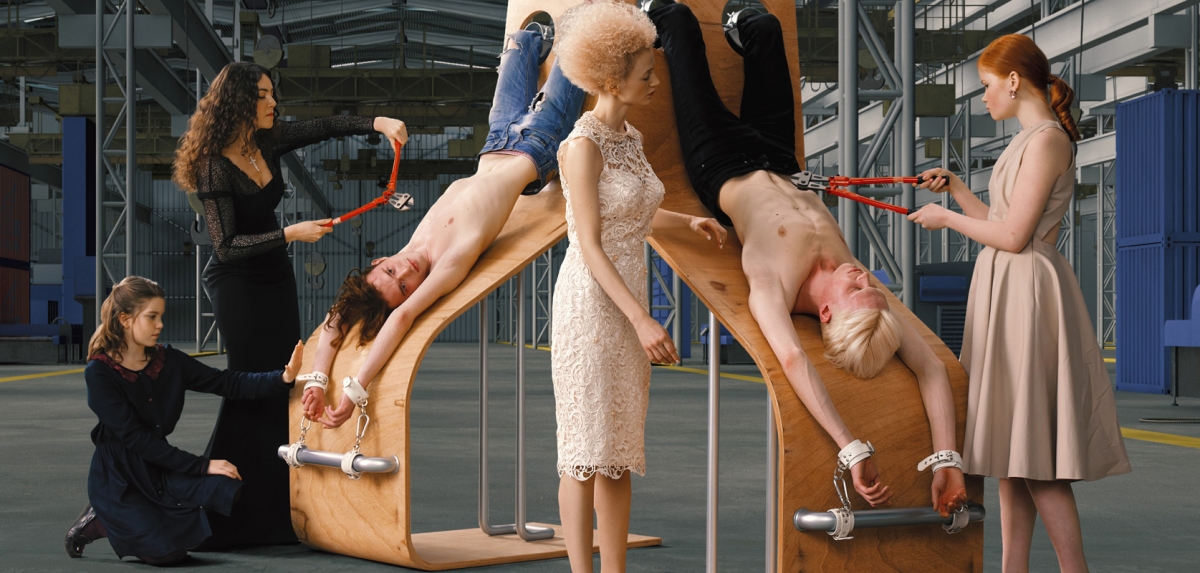 Inverso Munus
, still
Inverso Munus
, still
Violence is a recurring theme in your video work. In each scenario, the actors' faces are totally neutral and no one seems to be in pain. The violence is not gory and there’s no blood. And yet, we have children piercing each other with bows and arrows, swords poised at people’s necks, and like you said, women "torturing" men on these rotating devices. You’re not representing violence, but you’re simulating it. Violence is depicted in this kind of glamorous way as if it were the theme of an editorial fashion shoot. How did you decide to depict violence in this way, and what do you think that it says about our society’s relationship to violence and images of violence?
The first time we began depicting violence in this style was in our Last Riot project. In the project, we spoke about virtual reality and video games where the violence became more and more glamorous and became some kind of entertainment. You can kill a lot of people during video games with no punishment for your actions—you’re self-indulgent. So this kind of violence, of course in some kind of ironic way, shows this culture of violence as entertainment in virtual reality.
At the same time, we based it on Baroque paintings that depict heroes in aesthetically beautiful battles that also involve this very special violence. It’s traditional for culture to show violence as beautiful. But somehow, the Baroque is similar to contemporary video games. It’s the apocalypse.
 Inverso Munus, Still #1-03
Inverso Munus, Still #1-03
Your aesthetic references static styles of imagery like the Baroque tableau or fashion photography, but as the compositions start to move and shift, they begin to feel like a video game. The medium itself is somehow in-between photography and video—like animated photography. Can you describe how you make these moving animated images?
The idea is that we don’t use a video or film camera, but we use photography. We animate thousands of photographs. It’s a very special kind of choreography where the characters seem to move like robots—social robots we’ll call them. From there, we also have a special way of editing. The photographs have very thick resolutions so when you combine them, you can make huge compositions where every figure and element is in very high resolution. It gives the possibly of special high-res picture, which is impossible in reality.
Also this atmosphere of alienation is very important for us. All of these cameras shoot the figures separately so they don’t ever look at each other. Each is shot at different locations and then just united in the composition. And we don’t use atmospheric perspective because figures on a main plain are not on the same plane as those in the background, for example. It gives the atmosphere without the air. You cannot breath there without these atmospheric perspectives.
 ALLEGORIA SACRA, Stills 3-3-10
, 2011 is availble on Artspace for #3,734
ALLEGORIA SACRA, Stills 3-3-10
, 2011 is availble on Artspace for #3,734
Switching gears, what is it like to work with four people to make a single piece?
This is a very simple process. All of us discuss the ideas and when we have some kind of common vision and solution for the next project, we divide our skills. For example, some of us are photographers, some are better with computers, and during all the stages of production we all supervise the process from different perspectives. And of course, we also work with assistants.
We not only work in video and photography, but we also make sculptures, paintings, drawings, and use more traditional mediums. The project usually consists of several parts and video is just one of them. It could be a series of paintings, prints, stills from the video, sometimes sculptures, objects, and so on. All together they form a complete project, which could be shown in different combinations depending on the venue or idea of the exhibition.
 From left to right: Lev Evzovitch, Tatiana Arzamasova, Evgeny Svyatsky, Vladimir Fridkes
From left to right: Lev Evzovitch, Tatiana Arzamasova, Evgeny Svyatsky, Vladimir Fridkes
It seems like some of these works are part of the process. You’ll make sculptures that will become props in the videos, or you make sketches in preparation for the videos, and then after the video is made you take stills and panoramas—so every step of the process you’re producing something. Why have so many versions of the same thing?
It’s not the logic of the same thing. Different media have different meanings. For example, sculpture is very important for us because it is some kind of material object instead of a virtual object. I think it works very well when the virtual manifests in the material. It embodies our contemporary vision that everything is mixed.
Also when we want moving images for video, we make certain compositions for the videos, and then make separate compositions for our digital collages. They give us different means of expression and can add different meanings by using different media. All together, they inform the main idea from different viewpoints.
 Inverso Mundus, Inquisition or Women's Labor #2
, 2015, oil on canvas
Inverso Mundus, Inquisition or Women's Labor #2
, 2015, oil on canvas
How did you start working together? How did you find each other and what were you doing beforehand?
We met in the end of the ‘80s and before that we just worked separately in different directions. For example, Lev worked in the animation industry and Tatiana worked as a conceptual architect. Together, we got a commission from a very famous Russian theatre director to make the costumes for his production. So that was a good beginning for our coming years.
Speaking of some of your earlier work, one of your earlier projects was called “The Islamic Project” and you worked on it from 1996 to 2003. Soon after the Trump administration implemented the what's been called the “Muslim Ban,” I was scrolling my Instagram feed and came across this very powerful image that rendered the Statue of Liberty as wearing a hijab and holding the Qur’an. I wasn’t familiar with the work and I assumed it was a contemporary work in response to Trump’s policy. Then I looked into it and realized it was your work from the ‘90s. I’m wondering if you can tell me a little bit about the project that that image came from?
The project started in 1996 and was about paranoia. The image was a parody on this paranoid vision of Islamophobia that people like Trump, and also other heads of false authority, spread by fostering fear throughout Western civilization about Islamic fundamentalism. But also for us at that time, it was very important to show this “alternate” globalization upside down. At that time, there was this widespread idea that there would be a liberal democracy with a free market economy, exemplified by the spreading of McDonalds all over the world, or a Westernization of the globe. Now it is obvious that globalization also spreads other cultures to the West.
 New Liberty
, 1996, digital collage
New Liberty
, 1996, digital collage
Is you work a political statement?
Of course our work has this political lens, but this is not “political art” because we don’t make any statements that belong to a definite party. Our work is a kind of reflection of the contemporary reality, a kind of provocation, which gives the spectator his or her own ideas about what is happening to the world. We are not political activists, but we have this element of political deconstruction in our projects.
Also the idea was to use our projects as a sort of social psychoanalysis. When they’re shown at exhibitions they always provoke discussion among visitors. So the work doesn’t need to be at the center of discussion because people start to talk to each other about “political correctness” and the depicted issues on their own. So always it became a way to position people to argue, to challenge them on what they really think about this political process and relationships between cultures.
Can you tell me anything about what you’re working on now?
One of the projects is inspired by Turandot —the 19 th -century opera by Giacomo Puccini. We like this opera because the princess character is ultra-feminist. But in our version we show a futuristic China in 2070 when it is this great world power, and it’s a society of cyborg feminists. Another project we’re working on is more about refugees. It’s a series of traditional porcelain sculptures about the Mediterranean Sea and refuges.
[related-works-module]











